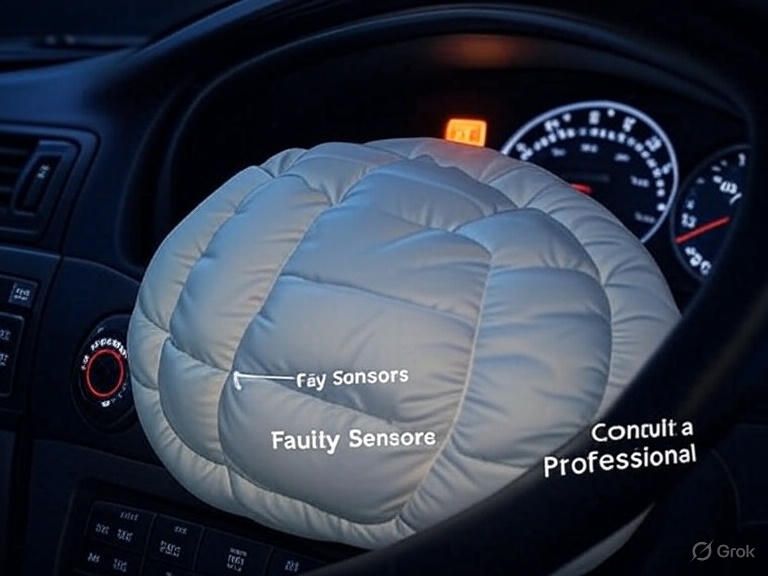Why Recurring Airbag Warnings Matter: Causes, Solutions, and Safety Risks
Key Takeaways
- Airbag warning lights are critical safety alerts, not minor nuisances.
- Common causes include faulty sensors, electrical issues, depleted backup batteries, seat belt pretensioner problems, and unresolved post-accident faults.
- Prompt diagnosis and repair are crucial to ensure airbag functionality in a collision.
- Ongoing or unresolved warnings can impact your car’s resale value and safety rating.
- Consulting professionals and regular maintenance are essential in keeping your airbag system reliable.
Understanding Airbag Warnings
A lit or blinking airbag warning light on your dashboard is never something to ignore. This isn’t just an inconvenient indicator; it’s a crucial alert that your vehicle’s primary life-saving system could be compromised. Airbags are an integral part of your vehicle’s supplemental restraint system, designed to protect you and your passengers in the event of a collision, often serving as the first and last line of defense between vehicle occupants and serious injury. Modern vehicles are equipped with highly sophisticated sensors and control modules that constantly monitor these systems for real-time faults or compromises. If a problem is detected—no matter how small or infrequent—it is immediately communicated to the driver via a dedicated warning icon, usually a figure seated with a deployed airbag in front.
Addressing airbag system issues swiftly is especially important in vehicles known to experience reliability concerns, such as certain models experiencing frequent Dodge Journey problems. Recurring airbag warnings can be symptomatic of deeper electrical or mechanical problems in these vehicles. Many drivers who experience these issues discover that ignoring the initial warning can lead to a bigger, more expensive failure of the airbag system or other connected systems in their cars. Since the airbag system communicates with the vehicle’s computer, recurring faults may impact diagnostic efforts for other unrelated, but equally important, components. Prompt attention is critical for safety and for preserving vehicle function.
Common Causes of Airbag Warnings
Faulty Sensors
Your car’s airbag system relies on specialized sensors to ensure airbags deploy correctly and only when truly needed. These sensors are continuously vigilant, measuring impact force, vehicle speed, occupant presence, and seat weight distribution. If any sensor malfunctions—because of age, direct damage, moisture intrusion, or calibration errors—it can cause the airbag light to turn on. Not only can faulty sensors prevent the system from deploying airbags when needed, but they may also trigger unnecessary deployments or continually illuminate the warning light, creating confusion for drivers. Sensor faults frequently occur due to regular wear and tear or failures caused by short circuits, water ingress from leaky windows or doors, or subpar repairs after an accident.
Electrical Issues
The advanced network of wiring that powers your airbag system is vulnerable to various kinds of electrical problems. Common electrical issues like corroded wiring, loose or broken connections, or short circuits can interrupt communication between the airbag control module and the system’s sensors and actuators. This is especially true in older vehicles or those undergoing major repairs after a crash. Even minor voltage fluctuations, caused by a dying alternator or a discharged main battery, can create inconsistencies in the system’s power supply, triggering a warning light. Moisture from weather conditions or car wash leaks, improper aftermarket installations of electronic devices, and rodent damage are all culprits behind impaired electrical connections in the airbag circuit.
Depleted Battery Backup
Unlike some vehicle systems that only function when the main car battery is active, modern airbag systems are designed with their rechargeable backup power source to ensure airbags deploy even if the main car battery is disconnected during a severe collision. However, if the main battery remains low for extended periods or dies completely, the backup might also lose its charge, resulting in a fault code and a dashboard warning. Drivers who frequently jump-start their cars, replace batteries, or drive vehicles with weak electrical systems are more likely to encounter this issue. Sometimes, the warning light may appear after a battery swap and might not clear until a technician resets or tests the airbag circuitry.
Seat Belt Pretensioner Issues
Seat belt pretensioners play a crucial role in occupant safety, tightening seat belts milliseconds before the airbags deploy. If these pre-tensioners develop faults—due to broken internal mechanisms, frayed wiring, or failed seat belt latches—the vehicle’s onboard computer may fail the entire supplemental restraint system and illuminate the airbag warning light. Pretensioner damage can also occur due to minor accidents that do not trigger airbag deployment or even from repeated tugging and stress on seat belts during normal use. The airbag and seat belt systems may be affected if this component is compromised.
Previous Accidents
Suppose your car has experienced an accident where the airbags didn’t deploy. In that case, the crash may have triggered a fault code in the airbag control module, depending on the severity and nature of the impact and the design of your vehicle’s safety system. The dashboard warning light may persist unless the fault code is professionally cleared and a comprehensive system check is performed. This is not only a reminder of unresolved issues but also an important warning that previous repairs—either on the airbag system itself or other connected parts—might have been incomplete or improperly carried out. In some models, the airbag warning might indicate hidden frame damage, improperly seated sensors, or corrosion in wiring harnesses unexpectedly exposed by bodywork repairs.
What to Do When an Airbag Warning Appears
Consult a Professional Mechanic Immediately
Airbag systems are technically advanced and interconnected with multiple sensors and modules that demand expert attention. While some car enthusiasts may be able to read basic trouble codes using a personal diagnostic scanner, most drivers lack the tools and training to safely and successfully address system issues. Professional mechanics and dealership technicians have access to proprietary diagnostic equipment and up-to-date recall information, enabling them to identify a fault’s root cause quickly. Addressing a warning light promptly with a certified mechanic ensures the airbags work as designed in an emergency. Attempting to fix or tamper with airbag systems is dangerous and may void warranties.
Check for Manufacturer Recalls
Some airbag problems are widely known to manufacturers, resulting in national or global service campaigns and safety recalls. The infamous Takata airbag recall affected millions of vehicles worldwide, with many drivers unaware their car was equipped with a defective airbag until a warning appeared. If your vehicle is covered, repairs will be performed free of charge. Manufacturers regularly add new models and years to active recall lists even if you haven’t received a formal recall notice.
Keep Up With Regular Vehicle Maintenance
Routine vehicle maintenance—including scheduled diagnostics, visual inspections, and system checks—helps catch minor airbag system faults before they escalate into major failures. Many automakers recommend annual or semi-annual airbag system inspections as part of regular service, particularly for older vehicles, high-mileage cars, or models with known electrical problems. During a scheduled service visit, technicians can verify airbag module operation, sensor health, wiring integrity, and recall status. Proactive maintenance is one of the simplest and most effective ways to maintain long-term safety and peace of mind on the road.
Why Ignoring Airbag Warnings Is Dangerous
Ignoring an active airbag warning increases your risk of serious injury or death during a collision. When the warning light is on, the vehicle’s system has already detected that one or more components may fail to operate properly in a crash. As a result, airbags may not deploy when you need them most, or they might deploy incorrectly, which is extremely hazardous. Beyond the immediate safety threat, a persistently lit airbag warning light can mask new or unrelated system issues, making diagnosis more difficult for technicians and increasing the likelihood of catastrophic system failure.
Unresolved airbag warnings can also lead to much more expensive repairs. Allowing a problem to persist might cause related components—such as crash sensors or electrical modules—to fail, requiring wholesale system replacement instead of minor part repairs. Additionally, your car’s resale value will drop considerably if you trade in a vehicle with an active airbag warning, as prospective buyers and dealerships may view this as a sign of hidden, expensive-to-fix damage.
Conclusion
Airbag warning lights command your immediate attention. With causes ranging from minor electrical faults to critical system failures, their presence always deserves a proactive approach. Whether you’re dealing with ongoing mechanical problems or other common vehicle concerns, staying vigilant about airbag system alerts ensures you, your passengers, and other road users stay as safe as possible. Schedule regular professional maintenance, respond quickly to dashboard warnings, and consult recall databases frequently—even if you have not experienced any issues. By taking these steps, you help guarantee this vital safety system will be ready when you need it most, protecting both lives and property on every journey.

